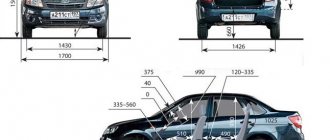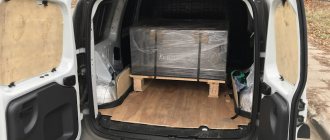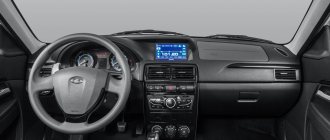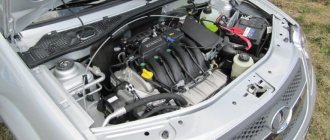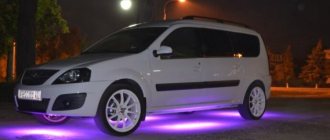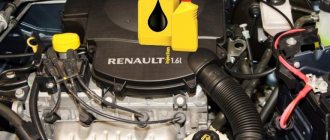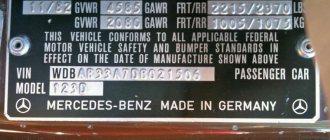| 1.6 l 16-cl., 5MT, 105 hp | |
| Wheel formula / drive wheels | 4 x 2 / front |
| Body type / number of doors | station wagon/5 |
| Length / width / height, mm | 4470 / 1756 / 1682 |
| Front/rear wheel track, mm | |
| Luggage compartment volume, l | |
| Engine | |
| engine's type | gasoline, four-stroke |
| Supply system | distributed injection with electronic control |
| Number, arrangement of cylinders | |
| Working volume, cubic meters cm | |
| Maximum power, hp / kW / rev. min. | |
| Maximum torque, Nm / rev. min. | |
| unleaded gasoline AI-95 (min) | |
| Dynamic characteristics | |
| Maximum speed, km/h | |
| Acceleration time 0-100 km/h, s | |
| Fuel consumption | |
| Combined cycle, l/100 km | |
| Permissible total weight of a towed trailer with brakes, kg | |
| Transmission | |
| Transmission type | mechanical/5 |
| Main gear ratio | |
| Steering | |
| Steering gear | rack and pinion steering mechanism |
| Dimension | 205/55 R16 (91 H/V) |
Technical characteristics of Lada Largus Cross 7: high-quality platform and impeccable assembly!
Immediately after being introduced to the general public and due to its characteristics, the Lada Largus Cross 7 became incredibly popular. Firstly, the car is built on a high-quality VO platform. The platform is manufactured using technologies similar to those used by the Renault-Nissan alliance. However, the platform for Largus Cross 7 is specially adapted to Russian realities. Secondly, steel body panels with double-sided zinc finishing make the model presentable and recognizable, which creates good aerodynamics.
Lada-Largus with all-wheel drive - technical characteristics, appearance, when it will appear
Lada Largus Cross 4×4 is one of the most sensational new products in the domestic automobile industry, because this car took all the advantages of Largus, to which tuning was added: all-wheel drive and increased ground clearance.
The model was released at the end of 2014, and we can already safely say that the car is becoming popular in the domestic car market. The car perfectly withstands all the “delights” of our roads, rarely breaks down, and finding spare parts for this Lada is easy. Return to contents
Technical characteristics of Lada Largus Cross 7: capacity and transformation
This model has a modern design and a spacious interior. In its price class, LADA Largus Cross 7 is the only car that can accommodate not 5, but 7 adult passengers of average height and weight. The rear seats fold easily, freeing up free space for the owner's needs. The car can be easily transformed into a mini-truck with two passenger seats and large luggage space for transporting large items.
Also, based on the characteristics of the LADA Largus Cross 7, we can conclude: the car is ideal for long family trips with children. On the road in the warm season, you can always park by the side of the road, fold down the chairs and arrange comfortable sleeping places.
However, Largus Cross 7 is definitely not suitable for setting speed records. The design cannot be called luxurious. But all this doesn’t matter if we are talking about a family car for Russian realities.
The “under-hood” technical characteristics of the LADA Largus Cross 7 are the most important part of the discussion of this model. The car boasts a gasoline engine with a fuel injection distribution system. There are 4 cylinders in one row, the power unit is 1598 cubic centimeters. The power, of course, is not the strongest, only 105 hp. s, but if we remember that we are talking about a large family car, then it does not seem so weak. 165 km/h for a car with 7 passengers is the norm. Acceleration to hundreds in 13.5 seconds is on the one hand long, but on the other - who needs a rush if there are children in the cabin?
You can look at the car with your own eyes and take it for a test drive at any Anatomy showroom - an official Lada dealer in Moscow.
The multi-purpose station wagon with increased capacity Lada Largus is undoubtedly one of the most successful projects of the domestic automobile industry. The car was developed by AvtoVAZ together with the Renault-Nissan alliance based on the Romanian Dacia Logan MCV and went on sale in 2012. The station wagon, modified to suit Russian conditions, immediately began to be in high demand, which, taking into account all the advantages of the model and the price tag set for it, looked quite expected. Even in conditions of a serious market decline in 2014, dealers managed to sell more than 65 thousand Largus, which is 7.5 thousand more than a year earlier.
It has already become traditional for the Togliatti-based automaker to produce so-called “pseudo-off-road” versions of a number of its running models. For example, in December 2014, sales of a car built on the basis of the regular Kalina station wagon started. As for the Lada Largus with the Cross prefix, such a modification will soon also appear in car dealerships. At the very least, the start of its production is scheduled for February 7, 2015. Moreover, the technical characteristics of the new product are already known and its cost has been announced. Prices for Lada Largus Cross start at 553 thousand rubles.
Let's start getting acquainted with the technical features of the all-terrain vehicle by indicating the external dimensions of the car. The length and wheelbase of the Largus Cross remained at the level of the donor model - 4470 and 2905 mm, respectively. The width has increased by a symbolic 6 mm, amounting to 1756 mm. But the height of the “crossover” version of the Lada Largus is predictably higher - 1682 mm versus 1636 mm recorded for the classic modifications. The main difference between the “off-road” station wagon is the ground clearance increased by 25 mm, providing 170 mm of clearance under the bottom.
The exterior of the Largus Cross almost completely replicates the appearance of the base station wagon. The changes affected only those parts of the body that needed to be given the necessary protection to overcome off-road areas. As a result, the car acquired a solid plastic body kit covering the front and rear bumpers, door sills and wheel arches. In addition, the Largus Cross station wagon received 16-inch wheels instead of the more usual 15-inch ones.
Changes in the interior of the new product are also minimal, and, in fact, they boil down to the use of orange inserts in the design of various interior elements, such as the center console, door trim, and the backs of the front seats. The original orange stitching is used on all car seat upholstery. Another distinctive feature of the interior of the off-road modification of the station wagon is the plastic door sills with the inscription “Largus Cross”.
There are no other updates for the interior of the off-road Largus, which means that otherwise we are faced with a familiar configuration with characteristic nuances. The list of ergonomic miscalculations is not too long, and they are mainly inherited from co-platform donors. Inconveniences include the unusual location of the front window control buttons on the center console, as well as the not very good placement of the climate control unit. There are also a number of small flaws that do not cause significant discomfort, and over time you stop paying attention to them altogether.
The main advantage of the station wagon is the large amount of free space that is provided to passengers of any of the 2 or 3 (for 7-seater versions) rows of seats. Well-shaped seats with noticeable lateral support and a heating function will allow you to sit comfortably in the front. The driver's seat is height adjustable and also has adjustable lumbar support. The second row is no less comfortable than the front; three tall passengers can fit here with plenty of room, maintaining headroom and knee freedom. The seven-seater version of the Lada Largus Cross assumes the presence of another sofa with two seats in the back. Access to the “gallery” is quite acceptable, and you can sit in it without feeling particularly cramped.
An undoubted source of pride for the basic Lada Largus station wagon, and therefore its brother with the Cross prefix, is the super-spacious luggage compartment. The seven-seater version of the car, if all passengers are present, is ready to take an additional 135 liters of cargo, the five-seater version – 560 liters. The maximum usable trunk volume with the second row seats folded (and the third row seats removed in the case of a 7-seat configuration) is an impressive 2350 liters. The only upsetting thing is that there won’t be a level loading area with the rear seats folded down. The annoying step is formed due to the fact that the rows of station wagon seats are arranged in an amphitheater, that is, each subsequent row is located higher than the previous one.
Technical characteristics of Lada Largus Cross
| Parameter | Largus Cross 1.6 5-seater | Largus Cross 1.6 7-seater |
| Engine | ||
| engine's type | petrol | |
| Power type | distributed injection with electronic control | |
| Number of cylinders | 4 | |
| Number of valves | 16 | |
| Volume, cubic cm. | 1598 | |
| Power, hp (at rpm) | 105 (5750) | |
| Torque, N*m (at rpm) | 148 (3750) | |
| Transmission | ||
| Drive unit | front | |
| Transmission | 5 manual transmission | |
| Suspension | ||
| Front suspension type | independent MacPherson type | |
| Rear suspension type | semi-independent torsion beam | |
| Brake system | ||
| Front brakes | disk | |
| Rear brakes | drums | |
| Tires | ||
| Tire size | 205/55 R16 91H/V | |
| Fuel | ||
| Fuel type | AI-95 | |
| Tank volume, l | 50 | |
| Fuel consumption | ||
| Combined cycle, l/100 km | 9.0 | |
| dimensions | ||
| Length, mm | 4470 | |
| Width, mm | 1756 | |
| Height, mm | 1682 | |
| Wheelbase, mm | 2905 | |
| Front wheel track, mm | 1461 | |
| Rear wheel track, mm | 1466 | |
| Trunk volume, l | 560 | 135 |
| Maximum trunk volume, l | 2350 | |
| Ground clearance, mm | 170 | |
| Weight | ||
| Curb, kg | 1270 | 1300 |
| Permissible weight of a towed trailer with brakes, kg | 1300 | |
| Dynamic characteristics | ||
| Maximum speed, km/h | 165 | |
| Acceleration time to 100 km/h, s | 13.1 | 13.5 |
After getting acquainted with the interior, it’s time to return to the technical characteristics of the Lada Largus Cross. For the off-road version of the station wagon, unlike the donor model, there is only one power unit - the well-known 16-valve in-line engine with a volume of 1.6 liters and a power of 105 hp. The peak torque of such a motor is fixed at 148 Nm, which is achieved at 3750 rpm. The power from the power unit is transmitted to the front axle using a 5-speed manual transmission.
New Lada Largus Cross
will appear on the AvtoVAZ assembly line in October 2014, and a little later it will become available to buyers.
The car is a continuation of the new pseudo-off-road Lada Cross
. Let us remind you that the first car in this series is one that is already on sale.
The Largus Cross car has a number of external distinctive features by which the car can be unmistakably recognized on the road. Firstly, these are 16-inch alloy wheels. Let us remember that for a regular Largus they have a radius of 14 or 15. Secondly, this is a plastic body kit for the car, which, according to the designers, should make the car more practical for use on bad roads.
Well, the main advantage is the increased ground clearance of the Lada Largus Cross
, which is now more than 20 centimeters in running order, and when fully loaded, the very roomy seven-seater has a ground clearance of 170 mm. As a result, the ground clearance was increased by 25 mm when compared with the regular Largus.
Salon Lada Largus Cross
not much different from the interior of a regular 7-seater Largus, but there is one feature. As in the Kalina Cross interior, there are orange inserts in the center console, on the door trim and seat upholstery. Let's look at the photo of the Largus Cross salon below.
Luggage compartment Largus Cross
It has an additional third row of seats that fold just as quickly, opening up great opportunities for transporting various things.
However, it is worth recalling that the spare wheel on the Largus is located under the bottom, while on the Kalina Cross it can be found in the trunk under the mat. Which option is more convenient is a rather controversial question. Photo of the Largus Cross trunk
below.
Characteristics of VAZ Largus
Technical characteristics of VAZ Largus. Find out the dimensions, fuel consumption of the VAZ Largus, features of engines, suspensions, bodies and other technical characteristics of VAZ Largus vehicles.
Select VAZ Largus model:
Answers
History of VAZ Largus
In 2008, AvtoVAZ acquired from Renault the right to assemble and distribute cars under the Lada brand, built on the R90, F90 and B0 platforms, as well as a license to produce Renault engines (1.4 and 1.6 liters). This is how Lada Largus appeared - a joint project of the Tolyatti plant and the French corporation Renault-Nissan. The model completely copies the Renault Logan MCV of 2006, with the exception of a slightly modified facing of the false radiator grille and the LADA logo.
Impressive overall dimensions allow Largus to claim the title of the largest car among the B-class representatives. Length - 4473 mm, width - 1740 mm, height - 1640 mm (with handrails 1674 mm), wheelbase - 2905 mm, ground clearance - 160 mm. There are three modifications of the car: 5-seater, 7-seater and cargo van. Spaciousness is the key advantage of this car. In the seven-seat version, the luggage compartment is modest - only 198 liters. But the five-seater version already has 700 liters of useful volume, and by folding the second row we get 2350 liters. The cargo version is a 2-seater van with a cargo compartment volume of 2540 liters and a load capacity of 797 kg. The spare wheel is located under the bottom of the car.
Technical characteristics of Lada Largus Cross
In technical terms, Largus Cross will differ only in its upgraded, reinforced suspension. The well-known 5-speed manual transmission will be used as a gearbox. As for power units, there are no surprises waiting for us here either. The first pseudo-off-road vehicles will have a 16-valve engine, then the manufacturer promises a more affordable version with an 8-valve gasoline engine with a displacement of 1.6 liters. I would like to note that all modifications of the Cross will have roof rails on the station wagon. Next, look at the dimensions of the car.
Dimensions, weight, volumes, ground clearance of Lada Largus Cross
- Length – 4470 mm
- Width – 1750 mm
- Height – 1636 mm
- Curb weight – 1370 kg
- Gross weight – 1850 kg
- Base, distance between front and rear axle – 2905 mm
- The minimum trunk volume of the Lada Largus Cross is 135 liters
- maximum trunk volume of the Lada Largus Cross with the seats folded down is 2350 liters
- Fuel tank volume – 50 liters
- Tire size – 195/65 R16
- Ground clearance or ground clearance of Lada Largus Cross when fully loaded – 170 mm
We will tell you in detail about the 16-valve gasoline engine that will be installed on the Largus Cross. This is a classic DOHC with two camshafts. There are 4 valves per cylinder, there are hydraulic compensators. The timing belt acts as a timing drive. Power unit power 105 hp. This is a fairly reliable engine produced by the French company Renault. Engine characteristics of Lada Largus Cross
Further.
Lada Largus Cross engine, fuel consumption, dynamics
- Working volume – 1598 cm3
- Power hp – 105 at 5750 rpm
- Power kW – 77 at 5750 rpm
- Torque – 148 Nm at 3750 rpm
- Timing Drive - Belt
- Maximum speed – 165 kilometers per hour
- Acceleration to the first hundred – 13.5 seconds
- Fuel consumption in the combined cycle – 7.9 liters
Transmission
Front-wheel drive 5-speed manual transmission.
- front: spring, independent;
- rear: spring, semi-independent.
The body of the 5-door station wagon Lada Largus Cross 4x4 with a width of 1756 mm has a length of 4470 mm with a number of seats for 5-7 people, including the driver. The height of the car is 1682 mm. The useful volume of the luggage compartment varies from 135 mm to the maximum possible 2350 mm. With a wheelbase of 2905 mm, the front track differs from the rear by 5 mm (1461 mm and 1466 mm, respectively).
Prices and configurations of Lada Largus Cross
official price for the Lada Largus Cross with a 5-seater saloon is 553,000 rubles
.
Largus Cross with a 7-seater interior costs 573,000 rubles
. A very affordable price, considering that there are practically no competitors in this segment. As for the additional configurations of the car, for now the “off-road” station wagon will be offered only in the luxury version. The car will go on sale in the near future.
Video Lada Largus Cross
The presentation of Largus Cross to the general public took place at the Moscow Motor Show 2014. This video review of the car was also filmed there. A good video without unnecessary words, in which you can see all the features of the exterior and interior of the car. Watch the video Lada Largus Cross
.
It is worth noting that there are no plans to produce Largus Cross with a 4x4 all-wheel drive transmission
. That is, all Largus Cross will be exclusively front-wheel drive cars. But given the increased ground clearance, large wheelbase, impressive interior transformation capabilities, reliable French Renault platform and affordable price, this car will be an undoubted success.
When design is not particularly important, and the ground clearance inherent in SUVs is there, as well as a seven-passenger interior, a huge trunk can be purchased at an affordable price, then this is what all Russian residents dream of.
After all, as it happens, life stops in winter. At this time, a typical Russian resident of a small town is reading newspapers, watching TV, perhaps growing seedlings. But this person will not go to the dacha in winter. And there are only two reasons for this. Either the country house is not insulated, or the roads are covered in snow. AvtoVAZ recently presented the new Largus to the entire automotive community. And now the Russian summer resident need not be afraid of bad roads.
The first sales began in February 2015. In this model, the developers fully took into account all the requirements, as well as the wishes of motorists in our country. The car has become interesting not only to summer residents, but also to those who like to travel by car. Having such a car in the garage, you can forget about the problems of roads and their absence.
Among the competitors to the VAZ-Largus car at such an affordable price are only the Kalina-Cross and several Chinese models. But the fact is that the Chinese do not shine with their reputation. Therefore, it is worth taking a good look at this crossover.
Marketing move
Probably, the popularity of this car is due to the general interest in cars with SUV characteristics. Sales statistics also show that people are much more willing to buy those models that are in the crossover and off-road segment.
This trend was sensed by the marketing specialists at the Volzhsky Automobile Plant and it was VAZ-Largus that decided for a reason. By the time the model was to be presented to the general public, Largus was the most popular among the entire model range of the manufacturer. Among all the well-selling station wagons in our country, Largus was the leader. The station wagon gained such popularity thanks to an army of specialized automotive publications and forums on the Internet, where the merits of Logan in its new guise have been discussed more than once.
The new Largus has truly become one of the most successful representatives of the entire modern model range. The station wagon body allowed the car to provide good capacity. Under the emblem of the domestic manufacturer hides a reliable and already well-tested design from the French. AvtoVAZ management thus immediately killed two birds with one stone. A domestic station wagon has entered the automotive market, the reliability of which there is no doubt about. The price for a Lada-Largus-Cross car is from 600,000 rubles. Quite accessible to many residents of our country. In the wake of the great success of the ordinary Largus, they decided to give the car the elements and functions of an SUV and further increase interest and demand.
Appearance
Car reviews always focus on appearance and design. Just a quick glance is enough to notice something animalistic in the exterior. Even the name seems to have been copied from zoological reference books. The characteristic features were now evident in appearance. But first things first.
If we forget the noisy and beautiful presentation of this new product and all the good things that were said in the direction of the crossover by the company’s management, a small test (“Largus Cross”) was more likely to disappoint than to confirm the joy and delight of the development engineers.
The manufacturers promised a lot. The station wagon body had to be significantly modified. But in the end, all the modifications made that were supposed to add the potential of an SUV to the car were black plastic linings that were installed on the front and rear bumpers. The sills and wheel arches were also painted black, and the door frames and body pillars were also covered with black film.
The only modernization is increased ground clearance. On the crossover station wagon it is now 170 mm. The suspension was also modified and reconfigured to work off-road and asphalt.
The appearance is complemented by a 16” diameter and oversized tires. At AvtoVAZ itself, the set of plastic elements was called “aggressive design.” Now car enthusiasts and owners will have to somehow live with this.
It’s a pity that we don’t know how this aggression, created on the basis of black unpainted plastic, is manifested. Representatives of the manufacturer could not explain this, especially since plastic does not have any special capabilities, just like the body kit.
In general, the crossover is the French-Romanian hit Logan MCV from 2006, but with new bumpers and a different radiator grille. There is not an ounce of any aggression in his appearance. On the contrary, the appearance is completely utilitarian.
The slightly angular and heavy rear end, vertical pillars and tailgates give the car the appearance of a commercial bus. Simple optics, a smooth and flat roof, primitive handles and mirrors - this is what completes the review of the appearance of not the most elegant and graceful car. But a certain roughness is still good for a new SUV.
Interior
As soon as you get into the salon, you immediately see that nothing major has been changed in the interior. The driver's seat is still comfortable and can accommodate drivers of all sizes and shapes. In some configurations, the chair may have adjustable lumbar support and a steering column with settings in the vertical plane. To set the seat position, you can use simple adjustments.
The high seating position improved visibility. So, when you sit in the front seat, the view is almost perfect. Even the very wide A-pillars do not interfere with your ability to look at the road situation.
The front panel, as well as the electronic equipment, remains the same. Among the features is the horn. It is set in French, and for Russians this is a little unusual. Its button is now at the end of the right steering column toggle switch.
Finishing features
As for the features that are only available in the new crossover interior, these are orange leather inserts. The designers used these elements to decorate the backs of the front seats. Inserts can also be found in the shoulder area. Decorative stitching and checkered patterns in the same orange color adorn all seats. In addition, the center console and door trim are also trimmed in bright leather. What the designers were thinking is quite difficult to understand. But they still managed to slightly enliven the interior of the Largus Cross car. Feedback from motorists is generally positive. Although such a car is not purchased for its interior trim.
Interior
Official dealers, as we have already said, offer the Lada Largus Cross for 5 seats and for 7 seats. The interior layout is in many ways reminiscent of the universal version of the crossover, equipped with comfortable wide seats, ergonomic controls and additional shelves for small items.
Changes in the interior design are visible to the naked eye: leather inserts in bright colors have appeared on the center console and door panels, all seats are equipped with comfortable headrests. There are three-point seat belts. The design of the driver's seat is equipped with lumbar support. The steering wheel can be adjusted to its maximum vertical position.
The safety system of the all-wheel drive Largus is similar to that on European cars and is represented by airbags for the driver and front passenger, and side airbags that protect against injury in the event of a frontal collision.
The restyled version of the all-wheel drive Largus is available in two versions - five- and seven-seater, differing in the interior layout and luggage compartment volume. Folding seats allow you to quickly transform the seven-seater model into an all-terrain station wagon with all-terrain capability and spaciousness. The crossover is equipped with powerful roof rails and an additional luggage basket. The ability to load large items is available thanks to the hinged rear doors.
The five-door design greatly facilitates access to the cabin for third-row passengers. The cargo model of the all-wheel drive Largus allows you to load items through the side door.
Space
That's it, there is a lot of free space in the cabin of the 7-seater version. In general, spaciousness and large volume are one of the advantages that ensure high demand for this station wagon with SUV functions. There is plenty of space in all directions.
The second row of seats can accommodate three passengers in great comfort. At the same time, the landing will not just be comfortable. Passengers will not interfere with each other. If you install additional seats in the third row, you will add two more seats where even tall passengers can sit comfortably. But these chairs are located above the axis. Therefore, those sitting will feel the road “on themselves”.
Interior modifications
Currently there are 2 passenger variants and one cargo version on the market. Passenger versions are abbreviated R90 and differ in the number of passengers. In one case there may be 5 of them and the trunk volume in this design will be equal to 560 liters. In the second version there will be 7 passengers and the volume of the luggage compartment will be reduced to 135 liters. If desired, you can either remove the third row seats or fold them down and get a car with characteristics similar to those with 5 passengers.
Dashboard Lada Largus
The cargo van is designated by the abbreviation F90. The trunk volume in this version is a record one and amounts to 2540 liters. But there are only 2 seats available. That is, this car is completely focused on cargo transportation.
The body of the Lada Largus Van is very roomy
The Lada Largus in the "Van" body style has access to the cargo compartment from two sides
Technical characteristics of Lada Largus Station wagon 5 seats
Technical characteristics of Lada Largus Universal (taken from the official website)
Technical characteristics of Lada Largus Van
Technical characteristics of Lada Largus Van (taken from the official website)
Ergonomics and configurations
"Largus-Cross" is built on the basis of the maximum configuration of the regular "Largus". And this version is very rich. For an affordable price, the future owner will receive air conditioning, two airbags, a leather steering wheel, and heated front seats. The mirrors have an electrical adjustment function. The car is also equipped with a good-sounding audio system. There are roof rails on the roof. There are ABS and alloy wheels. This is almost an ideal option. There is everything you need, but there is nothing superfluous.
If we talk about ergonomic characteristics, then everything is ambiguous. If you ask the owners about the minor shortcomings of the Largus-Cross car, the feedback would be about the short driver’s seat cushion, the suboptimal backrest profile, weak lateral support, and the cargo position.
The owners also write that there is not much space in the second and third rows. In addition to all this, many did not like the new location of the horn button and window controls, which are now located on the center console.
But these are minor things. If you ask the owners of the Largus-Cross car about the advantages, the review will be different. Thus, the car attracts with a comfortable steering wheel, a clearly functioning gearbox, perfectly readable instruments, and a large cargo area when the seats are folded down. Also, many are pleased with the low loading height and rear gate. By the way, they open a full 180 degrees.
New body design and interior layout
Restyling has fundamentally changed the appearance of Largus. The front part is now completely different - there are new headlights, bumpers, fenders and hood. The radiator grille also received a different configuration, consistent with the signature X-shaped strokes. Another new product was given different side mirrors with built-in turn indicators and a shorter antenna on the roof. To top it off, the station wagon received new wheels.
Photo Lada Largus 2021 (Cross version)
Even more significant are the changes in the interior. The front panel from the first Duster, which is about to leave the stage, giving way to the second generation car, is integrated here. Largus got the steering wheel and instrument cluster from his Lada line-mates. The location of the buttons in the cabin has been revised: the power window control unit is placed on the door cards, and the seat heating buttons are placed on the console. An armrest appeared between the front seats (by the way, also new, with increased lateral support).
"Largus-Cross": technical characteristics
Only one unit was allocated for this car. The designers decided to use a 1.6 liter 4-cylinder petrol engine. The engine is equipped with 16 valves, timing and distributed fuel injection. The maximum possible power that this unit is capable of is 105 hp. s., but for this it is necessary to spin the engine to 3750 rpm.
In tandem with the power unit, AvtoVAZ installed an almost uncontested five-speed manual transmission. The “ensemble” of their engine and gearbox allows the car to reach speeds of up to 165 km/h. At the same time, the car can accelerate to 100 km in 13 seconds.
Fuel consumption in city conditions will be about 12 l/100 km. On the highway the engine consumes about 7.5 liters.
But with all this, you should take into account the cost of the Lada-Largus-Cross car. The price starts from 518,000 rubles.
A little history
The serial front-wheel drive station wagon Lada Largus appeared on the domestic car market in 2012. This was the well-known Dacia (Renault) Logan MCV of the first generation (2006), adapted to Russian operating conditions, built on the B0 platform (global access platform).
The car was offered to potential buyers in three versions - a 5- or 7-seater passenger station wagon, as well as a cargo van with blank rear and side panels.
The Largus was equipped with a choice of one of three power units with a capacity of 84, 87 or 102 hp. With. with a manual five-speed gearbox. They provided the car with the ability to reach speeds of up to 165 km/h. Fuel consumption when traveling in city/highway mode did not exceed 9 liters.
Having appreciated the modern exterior, spacious interior and large trunk volume of the new universal and relatively inexpensive car, which fully satisfies the requirements of an ordinary Russian family, from the first days of its appearance, the Lada Largus became the subject of a wide discussion about the need to develop an off-road modification equipped with all-wheel drive.
Bo Inge Andersson, who at that time served as president of AvtoVAZ PJSC, took an active part in resolving this issue. A luxury car LADA Largus VIP with increased engine power (135 hp) was prepared especially for it, which tested the capabilities of the enterprise during the transition to the production of higher-class cars.
